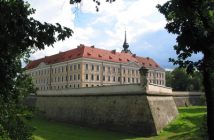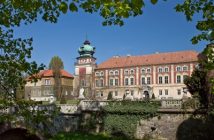The Bieszczady Mountains are somewhat of a mythical land even to Poles, a kind of ‘Wild West’, as indeed the region is still sometimes called. It is to the Bieszczady that people tired of the hustle and bustle of city life have been coming for decades, to get away from civilisation and to find old, simple values and sincere people. Visitors have always looked with envy at the vast open spaces and deep forests of a region where near neighbours often live several kilometres apart, and where nature is within arm’s reach.
The Bieszczady owe their position in the national consciousness to their own history. The first settlers came there in the 13th century, and in the 14th century, when this part of the Carpathian Mountains lay within the borders of the Kingdom of Poland, the region developed dynamically. However, after the partitioning of Poland at the end of the 18th century, the Bieszczady became a remote periphery of the Austrian empire.
During the First World War the mountains were divided by the Russian-Austrian front, and several major battles were fought there, resulting in almost 100,000 dead on the Austrian side alone and catastrophic devastation of the land.
During the Second World War the Bieszczady were largely spared, but afterwards Polish-Ukrainian tensions increased dramatically. Attempts were made to deport the Ukrainian population, which they answered with armed resistance, which was in turn followed by counteraction by the Polish communist authorities. This could only result in bloodshed. However, in 1947, the entire Ukrainian population was removed by force, and the villages in the Bieszczady were left almost completely deserted overnight. The ruins of houses and of entire villages gradually became overgrown with plants. It took a long time before people started coming to live in the Bieszczady again, and the region was for decades regarded as a wilderness, forcing very harsh conditions on those who wished to settle there. At present the Bieszczady are still one of the least populated regions in Poland, though the system of roads and telecommunications and power services are now well developed.
The fact that the Bieszczady Mountains lie away from civilisation, a rarity in contemporary Europe, has today made them a big attraction to visitors from all over the world. You are welcome to explore the Bieszczady too! (b)
The Bieszczady owe their position in the national consciousness to their own history. The first settlers came there in the 13th century, and in the 14th century, when this part of the Carpathian Mountains lay within the borders of the Kingdom of Poland, the region developed dynamically. However, after the partitioning of Poland at the end of the 18th century, the Bieszczady became a remote periphery of the Austrian empire.
During the First World War the mountains were divided by the Russian-Austrian front, and several major battles were fought there, resulting in almost 100,000 dead on the Austrian side alone and catastrophic devastation of the land.
During the Second World War the Bieszczady were largely spared, but afterwards Polish-Ukrainian tensions increased dramatically. Attempts were made to deport the Ukrainian population, which they answered with armed resistance, which was in turn followed by counteraction by the Polish communist authorities. This could only result in bloodshed. However, in 1947, the entire Ukrainian population was removed by force, and the villages in the Bieszczady were left almost completely deserted overnight. The ruins of houses and of entire villages gradually became overgrown with plants. It took a long time before people started coming to live in the Bieszczady again, and the region was for decades regarded as a wilderness, forcing very harsh conditions on those who wished to settle there. At present the Bieszczady are still one of the least populated regions in Poland, though the system of roads and telecommunications and power services are now well developed.
The fact that the Bieszczady Mountains lie away from civilisation, a rarity in contemporary Europe, has today made them a big attraction to visitors from all over the world. You are welcome to explore the Bieszczady too! (b)

Bieszczadzki mit
Bieszczady to dla samych Polaków kraina mityczna, nasz, jak przez lata mówiono, „Dziki Zachód”. Przez całe dziesięciolecia swego miejsca na świecie właśnie w Bieszczadach szukali ludzie zmęczeni życiem w zatłoczonych wielkich miastach, szukający oddechu od cywilizacji, okazji powrotu do prostych wartości i szczerych ludzi. Wyruszali tutaj. Do wielkich przestrzeni, potężnych lasów, gdzie od najbliższych sąsiadów dzieliły ich czasem kilometry, ale przyrodę mieli w zasięgu ręki.
Bieszczady tę pozycję w polskiej świadomości narodowej zawdzięczają swojej historii. Pierwsi osadnicy pojawili się tam w XIII wieku. W wieku XIV, kiedy ta część Karpat trafiła w granice Królestwa Polskiego, rozwój gospodarczy nabrał tempa. W końcu XVIII wieku, po rozbiorach Polski, Bieszczady znalazły się na peryferiach cesarstwa austriackiego.
W czasie I wojny światowej Bieszczady przecinał front rosyjsko-austriacki. Stoczono tu wielkie bitwy, które tylko stronie austriackiej przyniosły niemal 100 tysięcy ofiar, a krainie olbrzymie zniszczenia.
Druga wojna światowa oszczędziła Bieszczady. Jednak pod jej koniec na tym terenie zaostrzył się konflikt polsko-ukraiński. Poźniej były próby przesiedlenia ludności ukraińskiej, co spotkało się ze zbrojnym sprzeciwem, a ta z kontrakcją polskich władz komunistycznych. Przyniosło to wiele krwawych starć. Ostatecznie w 1947 ludność pochodzenia ukraińskiego została wysiedlona, a bieszczadzkie wsie niemal całkowicie opustoszały. Przyroda zaczęła stopniowo pokrywać zgliszcza, opuszczone domy.
Ludzie bardzo powoli zaczęli wracać w Bieszczady, do krainy, która przez dziesięciolecia uchodziła za dziką, stawiająca pragnącym się tam osiedlić bardzo trudne warunki. Dzisiaj nadal Bieszczady należą do najrzadziej zaludnionych regionów w Polsce, choć dysponują już dobrze rozwiniętą siecią dróg i usług telekomunikacyjnych czy energetycznych.
Oddalenie tych gór od cywilizacji, rzadko spotykane w dzisiejszej Europie stało się wartością, która budzi ciekawość przybyszów z całego świata. Poznajcie więc i Wy Bieszczady!
Bieszczady tę pozycję w polskiej świadomości narodowej zawdzięczają swojej historii. Pierwsi osadnicy pojawili się tam w XIII wieku. W wieku XIV, kiedy ta część Karpat trafiła w granice Królestwa Polskiego, rozwój gospodarczy nabrał tempa. W końcu XVIII wieku, po rozbiorach Polski, Bieszczady znalazły się na peryferiach cesarstwa austriackiego.
W czasie I wojny światowej Bieszczady przecinał front rosyjsko-austriacki. Stoczono tu wielkie bitwy, które tylko stronie austriackiej przyniosły niemal 100 tysięcy ofiar, a krainie olbrzymie zniszczenia.
Druga wojna światowa oszczędziła Bieszczady. Jednak pod jej koniec na tym terenie zaostrzył się konflikt polsko-ukraiński. Poźniej były próby przesiedlenia ludności ukraińskiej, co spotkało się ze zbrojnym sprzeciwem, a ta z kontrakcją polskich władz komunistycznych. Przyniosło to wiele krwawych starć. Ostatecznie w 1947 ludność pochodzenia ukraińskiego została wysiedlona, a bieszczadzkie wsie niemal całkowicie opustoszały. Przyroda zaczęła stopniowo pokrywać zgliszcza, opuszczone domy.
Ludzie bardzo powoli zaczęli wracać w Bieszczady, do krainy, która przez dziesięciolecia uchodziła za dziką, stawiająca pragnącym się tam osiedlić bardzo trudne warunki. Dzisiaj nadal Bieszczady należą do najrzadziej zaludnionych regionów w Polsce, choć dysponują już dobrze rozwiniętą siecią dróg i usług telekomunikacyjnych czy energetycznych.
Oddalenie tych gór od cywilizacji, rzadko spotykane w dzisiejszej Europie stało się wartością, która budzi ciekawość przybyszów z całego świata. Poznajcie więc i Wy Bieszczady!










